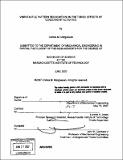Vibrotactile pattern recognition on the torso : effects of concurrent activities
Author(s)
Margossian, Christa M. (Christa Marie)
DownloadFull printable version (1.364Mb)
Other Contributors
Massachusetts Institute of Technology. Dept. of Mechanical Engineering.
Advisor
Lynette A. Jones.
Terms of use
Metadata
Show full item recordAbstract
Vibrotactile displays have been created to aid vision or hearing through the sense of touch. These displays communicate with the user to provide information. The focus of this thesis was to determine how concurrent activity affects vibrotactile signal recognition. An overall accuracy recognition rate of 90% or greater was desired from each of the signals in the each of the tasks. The first experiment asked subjects to wear the tactile display and walk while responding to signals. The results indicated that most of the subjects were able to recognize the patterns. The overall mean correct response rate was 92% and then when the subjects were asked to jog, they correctly identified the patterns 91% of the time. After determining the success rates from the first experiment, a second set of subjects were asked to concentrate on an internet game while responding to signals. The data from this experiment had an overall mean correct response rate of 93%. The results from this experiment further indicate that subjects can still receive communications while participating in other activities. The results also lead to specific conclusions about the patterns used and their ability to be identified with concurrent activity where some patterns are more easily received than others. By understanding how these patterns are recognized by humans, we can better develop patterns to communicate through tactile devices.
Description
Thesis (S.B.)--Massachusetts Institute of Technology, Dept. of Mechanical Engineering, 2007. Includes bibliographical references (leaf 25).
Date issued
2007Department
Massachusetts Institute of Technology. Department of Mechanical EngineeringPublisher
Massachusetts Institute of Technology
Keywords
Mechanical Engineering.